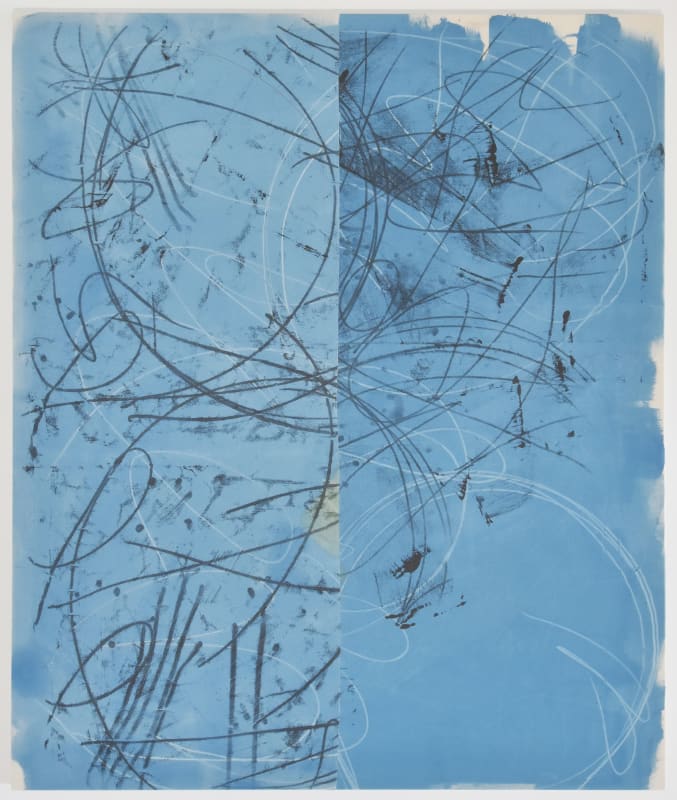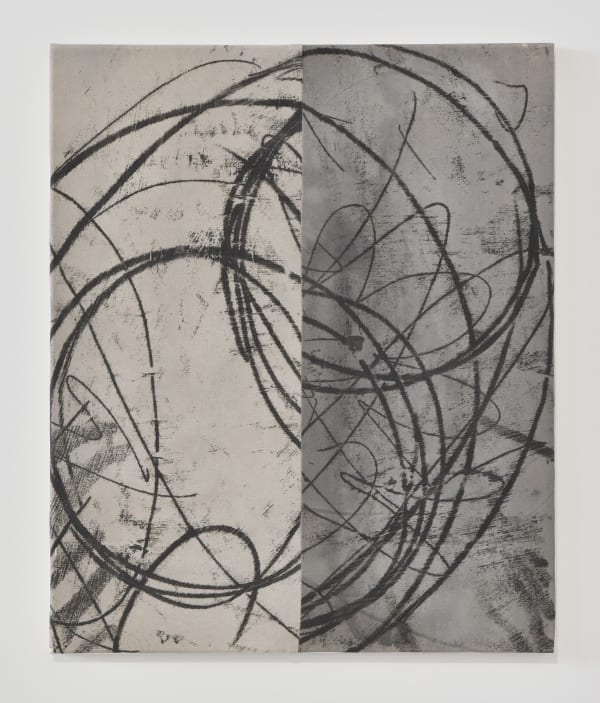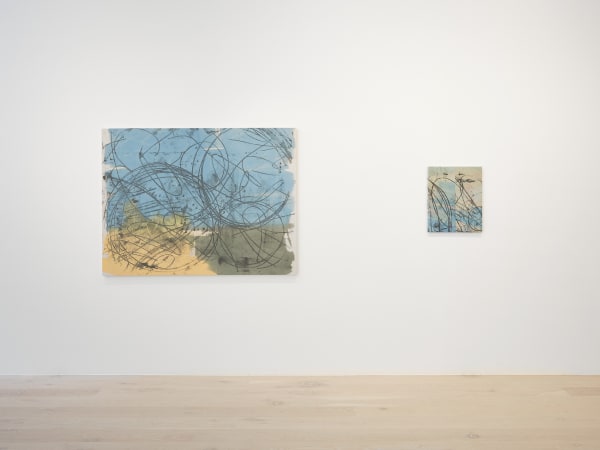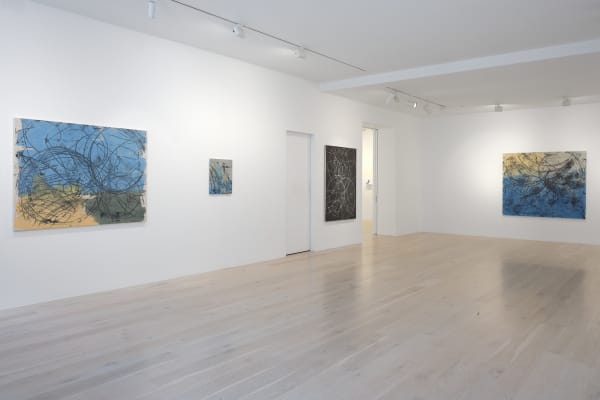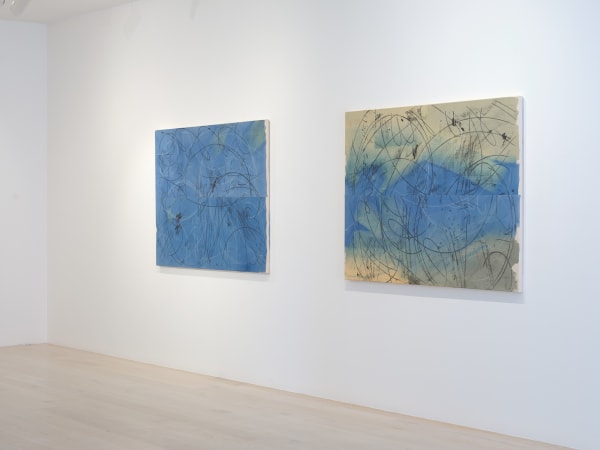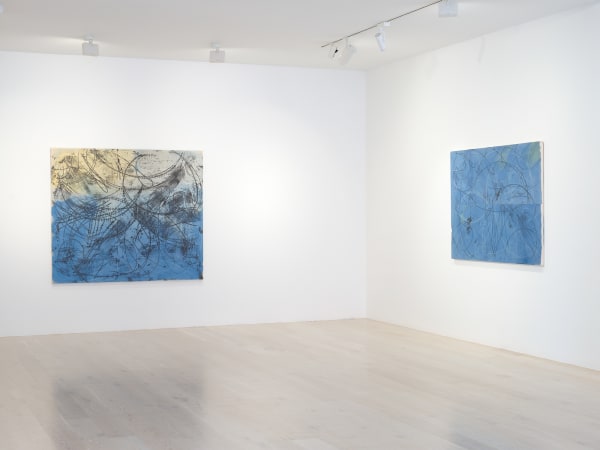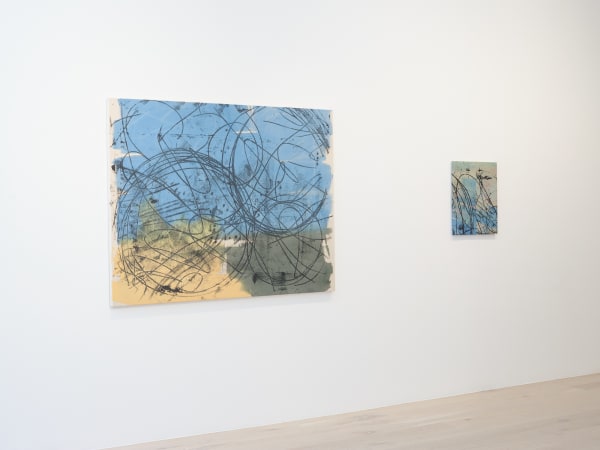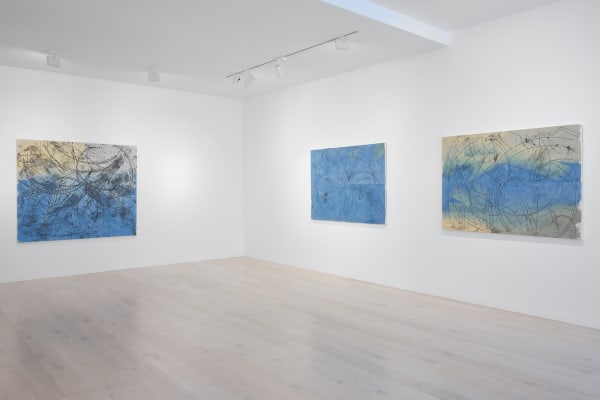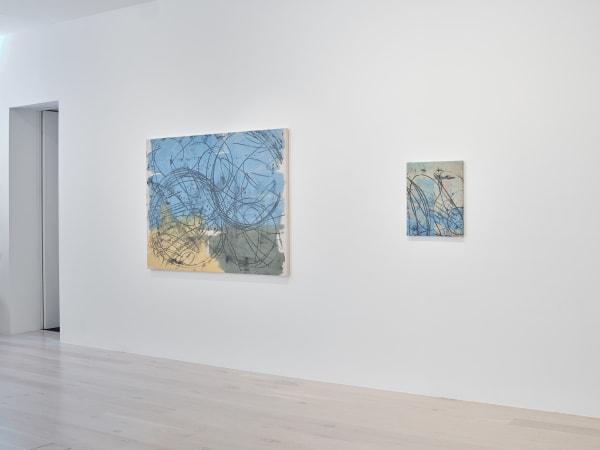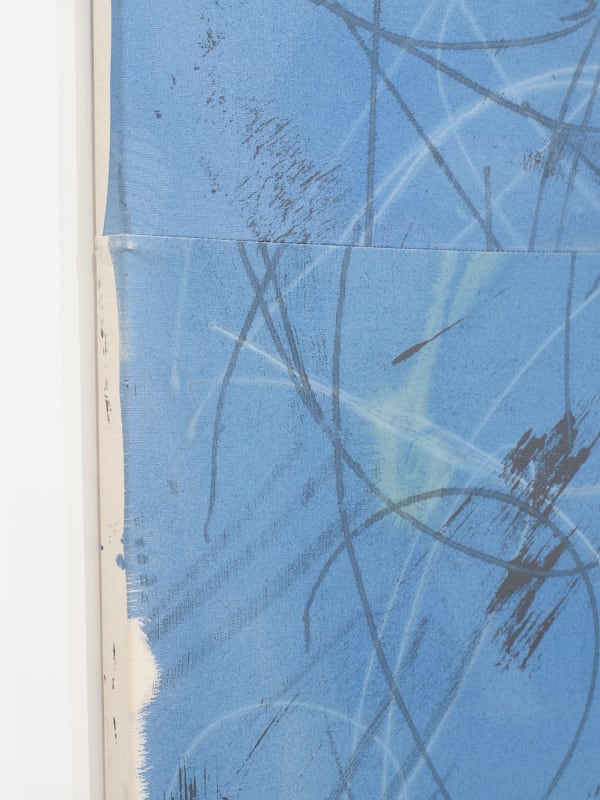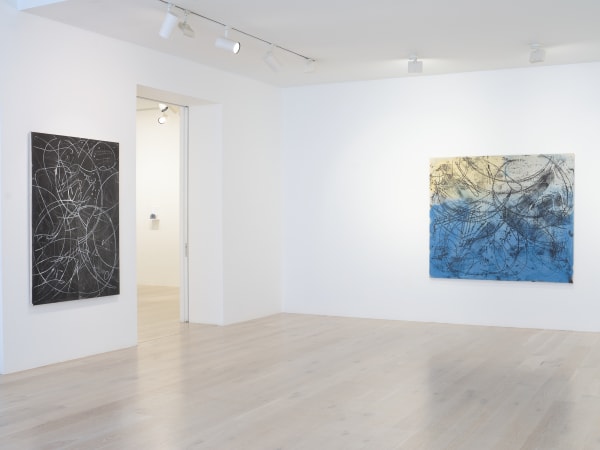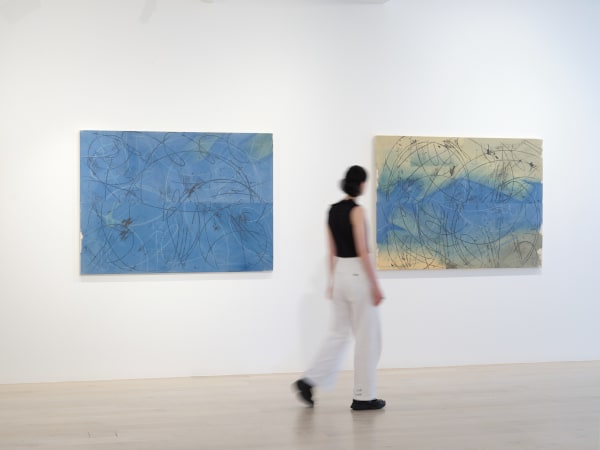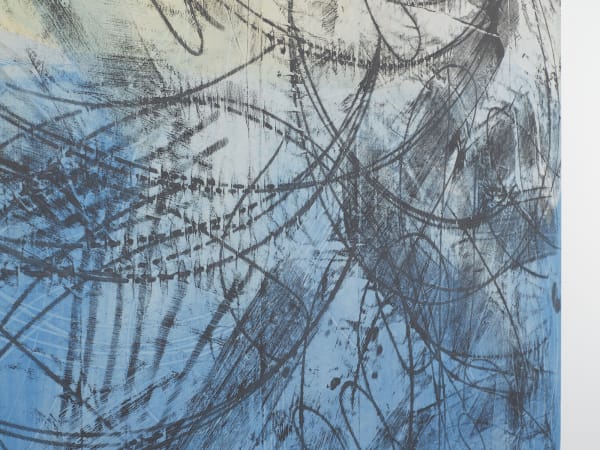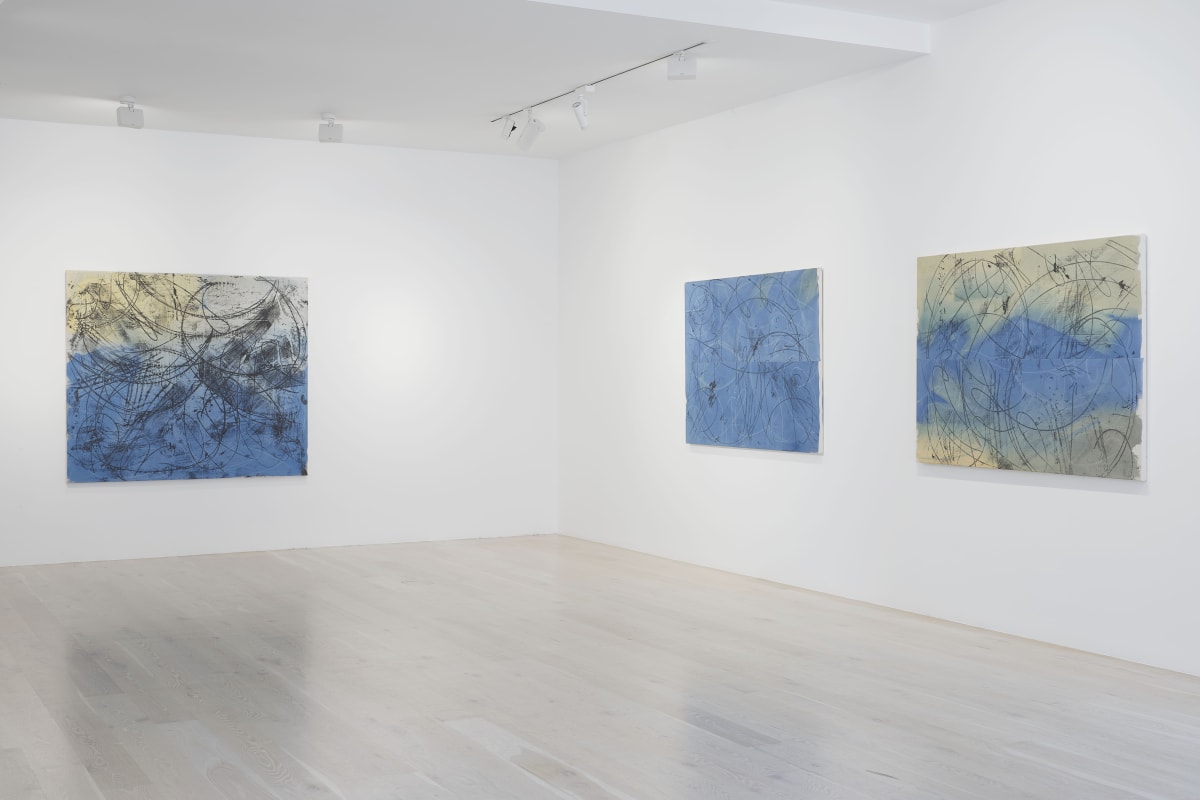The Plimsoll Line: Hugo Koha Lindsay
Lindsay’s conceptual practice involves responding to environmental cues that he encounters in an urban context – the incidental and temporal configurations of buildings and construction sites, roadworks, and city maintenance. Add to that load markings on the hulls of ships. These sources of visual stimulus aren’t depicted in any way, instead they feed into the visual sensibility of his work.
The Plimsoll Line presents Hugo Koha Lindsay’s latest body of paintings. These works bear a visual relationship to earlier iterations of his practice – with monochromatic or dichromatic palettes, clusters of abstract markings, and a clean, considered aesthetic. Yet, they differ in the level of intent behind the mark making. Lindsay’s earlier works made use of incidental processual markings, whereas the paintings in The Plimsoll Line feature more deliberate impressions.
-
 Hugo Koha Lindsay, composition 11: with notations, additions and subtractions, 2023
Hugo Koha Lindsay, composition 11: with notations, additions and subtractions, 2023 -
 Hugo Koha Lindsay, composition 4: with notations, additions and subtractions, 2023
Hugo Koha Lindsay, composition 4: with notations, additions and subtractions, 2023 -
 Hugo Koha Lindsay, composition 1: with notations, additions and subtractions, 2023
Hugo Koha Lindsay, composition 1: with notations, additions and subtractions, 2023 -
 Hugo Koha Lindsay, composition 7: with notations, additions and subtractions, 2023
Hugo Koha Lindsay, composition 7: with notations, additions and subtractions, 2023 -
 Hugo Koha Lindsay, composition 9: with notations, additions and subtractions, 2023
Hugo Koha Lindsay, composition 9: with notations, additions and subtractions, 2023 -
 Hugo Koha Lindsay, composition 2: with notations, 2023
Hugo Koha Lindsay, composition 2: with notations, 2023 -
 Hugo Koha Lindsay, composition 14: with notations, 2023
Hugo Koha Lindsay, composition 14: with notations, 2023 -
 Hugo Koha Lindsay, composition 13: with annotations, additions and subtractions, 2023
Hugo Koha Lindsay, composition 13: with annotations, additions and subtractions, 2023 -
 Hugo Koha Lindsay, composition 10: with notations, additions and subtractions, 2023
Hugo Koha Lindsay, composition 10: with notations, additions and subtractions, 2023 -
 Hugo Koha Lindsay, composition 12: with notations, additions and subtractions, 2023
Hugo Koha Lindsay, composition 12: with notations, additions and subtractions, 2023 -
 Hugo Koha Lindsay, composition 3: with notations, additions and subtractions, 2023
Hugo Koha Lindsay, composition 3: with notations, additions and subtractions, 2023 -
 Hugo Koha Lindsay, composition 8: with notations, additions and subtractions, 2023
Hugo Koha Lindsay, composition 8: with notations, additions and subtractions, 2023 -
 Hugo Koha Lindsay, composition 5: with notations, 2023
Hugo Koha Lindsay, composition 5: with notations, 2023
The Plimsoll Line presents Hugo Koha Lindsay’s latest body of paintings. These works bear a visual relationship to earlier iterations of his practice – with monochromatic or dichromatic palettes, clusters of abstract markings, and a clean, considered aesthetic. Yet, they differ in the level of intent behind the mark making. Lindsay’s earlier works made use of incidental processual markings, whereas the paintings in The Plimsoll Line feature more deliberate impressions.
Lindsay’s choice of title is intriguing. Plimsoll lines are markings on the hulls of ships to indicate load limits. Originally a circle with a line through the centre, Plimsoll lines have evolved to include additional markings that indicate a ship’s displacement in varying climates and types of water. Taken out of context, Plimsoll lines have an arcane appearance, which is likely the source of Lindsay’s artistic interest; transforming esoteric symbols into a contextual basis for artmaking is something that the artist has engaged in throughout his practice. Yet, the reference is not literal. As with other contextual frameworks he has engaged, such as council site markings in urban spaces, Lindsay has worked with Plimsoll markings interpretively. In fact, the sharp abstract paintings presented in the show do not bear any direct resemblance to the titular markings. Instead, they present groupings of scoured marks, circular lines and arcs set against vigorously applied sections of colour in restrained palettes.
Lindsay has built a practice that investigates painting as an informational system. This has often included the visual information of urban environments. Viewing the works in The Plimsoll Line, it is a different frame of reference that comes to mind – that of subatomic particles, and the images of post collision atomic pathways that have emerged from particle accelerator laboratories. In these paintings, one can discern impressions of atoms, electrons, and the traceries of subatomic realities. While this is very much an interpretive reading, it presents a view of how paintings can become informational matrices, presenting a viewer with a visual field to interpret according to their own frames of reference.
Abstract painting has often been a heavily conceptualised artform. This has the capacity to expand the discourse it sits within, though also to obstruct a clear view of the work itself. Intent on bringing the focus back to process, Lindsay states, “the activity of painting is its own concept.” He states that “the poetics of mark-making and its relationship to the body and the environment in which it was made” are central to his art-making practice. As much as his work is poetic and processual, its conceptual underpinnings are complex and nuanced – and this enhances rather than detracts from the paintings themselves. Lindsay’s conceptual practice involves responding to environmental cues that he encounters in an urban context – the incidental and temporal configurations of buildings and construction sites, roadworks, and city maintenance. Add to that load markings on the hulls of ships. These sources of visual stimulus aren’t depicted in any way, instead they feed into the visual sensibility of his work.
Lindsay cites a range of historical reference points that inform his work, including the fluid colour fields of Helen Frankenthaler, the quasi-graffiti of Cy Twombly, and the linear markings of Joseph Beuys’ chalkboards. His colour choices are informed by the natural world – bodies of water and celestial activity through contrasts of night and day. This constellation of influences plays out in Lindsay’s work as he creates a language of image making that is fresh, visually compelling, and informed by historic traditions of abstract painting.
